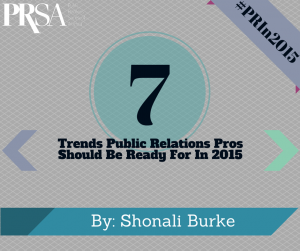Editor’s note: This is the 3rd in a series of guest posts from industry thought leaders predicting key trends that will impact the public relations profession in 2015. Follow the series and join the discussion by using the hashtag #PRin2015.
We practice public relations in fascinating times. The profession has seen changes we would never, ever have predicted. I mean, in which universe could you have imagined yourself saying:
- “I’m pretty sure I can do my work without the Bacon’s books.” Or:
- “Never mind about [mainstream media outlet]! Make sure [social media influencer] gets a press pass!” Or:
- “Of course your firm can be my agency of record. So what if you’re not in the same city?”
Given our track record, I’m somewhat loath to make PR predictions for 2015 that could so easily be upended in a decade or less. But I do think there are seven trends PR pros should be ready to grapple with:
- “PRTech.” I wish I’d coined this phrase, but I didn’t; the folks at AirPR did. And I think they’re right on the money. How we conduct public relations is getting more and more entwined with the data we can harness thanks to technology. So smart PR is going to use these better, and be shaped by them. It’s fascinating in a mind-bending kind of way, if you think about it.
- Measurement. The battle for smart measurement to become the norm has been an uphill one. However, we’re starting to see the pieces come together now.Industry groups (such as PRSA and AMEC) have really ramped up efforts to educate pros on smart measurement. Service providers are becoming more and more willing to provide smart yet affordable analytics solutions to businesses that don’t have several thousand dollars a month to spend on measurement dashboards. As a result, more and more businesses are willing to focus on outcome-based measurement, as opposed to the same old, tired, clips and impressions formula.
- Dealing with the millennial takeover. Millennials are entering management and executive positions, which means significant changes in how business is conducted.I asked my friend Maddie Grant, a thought leader in the Association & nonprofit space, what this means for PR, and she said:
“The PR community has been working hard to keep up with social media and the changes of the digital age, but that’s nothing compared to the revolution in business that is coming. The Millennials are ushering in a new era, where open sharing of information, fluid hierarchies and decision-making processes, and blinding speed are becoming the new normal—and that means the rules of the PR game are changing. Again.”
Maddie and co-author Jamie Notter have a new book coming out in March: When Millennials Take Over: Preparing for the Ridiculously Optimistic Future of Business. You might want to read it.
- Making content & SEO core to PR. For PR pros to call themselves “storytellers” is a popular trend, and I do think stories are critical to good PR. However, storytelling in the digital age is as much about generating solid and versatile content, all the while incorporating the principles of good SEO (search engine optimization). If you’re not incorporating owned media tactics into your PR efforts, then you’re missing a huge opportunity to practice social PR, which I strongly believe is the wave of our future.
- The rise of independent, alternative consultancies. I’m not saying this just because I run one, but in 2014, I saw a clear willingness on the part of clients to consider non-traditional agencies and consultancies for agency of record relationships. Why? They showed familiarity with social PR (#4 above), PRTech (#1 above), and focused on outcome-based measurement (#3 above).So while I don’t think traditional agency practitioners are by any means “dead,” I do think they will need to incorporate these elements into their business models fairly quickly. Else their pipelines and, ultimately, revenue streams will dry up.
- Reclaiming influence. This is, I think, an interesting, unanticipated consequence of our socially networked world. Over the last few years, we’ve seen “everyone” become an “influencer” (just like “everyone” is a “rock star”). And when everyone’s an influencer, then no one’s an influencer.I think we are going to see a gradual reclaiming of influence via exclusivity. There will be more niche events, more “exclusive” and/or embargo-type offerings to bloggers and media, and more generation of “buzz” by who’s not invited to the party, as opposed to who made the guest list.
- Media Relations. While traditional media outlets still haven’t found their sweet spot in the digital landscape, it hasn’t been for lack of trying. It has been interesting to watch the pendulum of influence swing back towards the media outlets that are starting to figure this out. So especially as “influencers” become more, well, influential, the art of media relations is going to take on increased importance. PR pros just have to remember to do it right, while not forgetting to integrate community management, content, and smart measurement into their plans.
Shonali Burke, ABC, is president & CEO of a social PR consultancy that takes your business communications from corporate codswallop to community cool™. She also teaches at Johns Hopkins and Rutgers, and is the creator of the #measurePR hashtag and Twitter chats, which celebrates five years in 2015.








[…] http://prsay.prsa.org/index.php/2015/01/20/7-trends-public-relations-pros-should-be-ready-for-in-201… […]